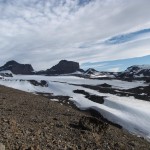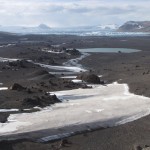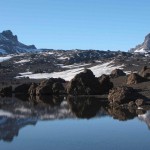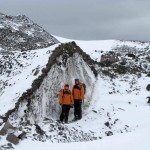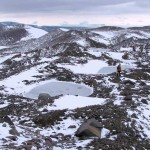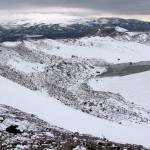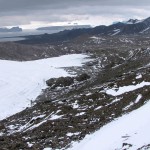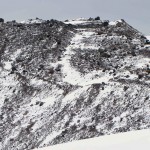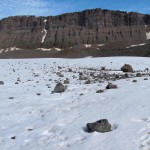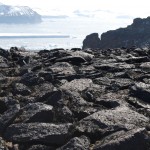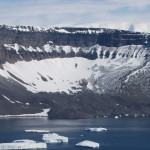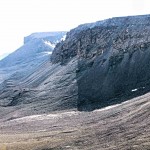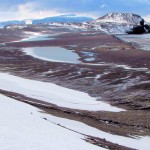This page is a shortened and simplified version of the paper by Davies et al. 2013, published by the Geological Society of London. It discusses a semi-arid subpolar landsystem and its paraglacial modification on James Ross Island, northeast Antarctic Peninsula.
Glacial landsystems | | Methods | Sediment-landform assemblages | Processes of landscape evolution | Glacial-paraglacial-periglacial interactions | Character and behaviour of the LGM ice sheet | Conclusions | Full citation | References | Comments
Glacial Landsystems
A landsystems approach encourages looking at the whole of a landscape to understand how it formed. A landsystems approach means understanding the landforms around, how they were formed (process-form relationships), through analysing both the sediments and the landforms. A series of sediment-landform assemblages make up a landsystem. Landsystems use modern landscapes to understand geomorphological processes, and characterise the terrain with repeated patterns of these sediment-landform assemblages 1,2.
Polar deserts were widespread during the time of the last glaciation, and are present today, both in the Arctic and the Antarctic. However, geomorphological processes are poorly understood in polar deserts, and the interrelationship between glacial, periglacial and paraglacial processes is poorly understood. The ‘paraglacial period’ responds to that period of readjustment from glacial to non-glacial conditions, with the reworking and relaxation of glacial sediments and landforms, such as steep, debris-mantled cliffs and large fluvial systems3. The ‘Periglacial environment’ refers to environments where the ground remains frozen for more than two years in a row, typically with the upper metre of so of the ground thawing in the summer season.
James Ross Island
James Ross Island is located on the northern Antarctic Peninsula. It lies east of the Trinity Peninsula mountains on the Antarctic Peninsula, and these mountains shield the island from precipitation. This is one of the reasons why the island has large ice-free areas. You can use the Google Map below to explore the ice-free portions of James Ross Island.
View Larger Map

The Ulu Peninsula on James Ross Island is relatively accessible, and is one of the largest ice-free regions in the northern Antarctic Peninsula. It therefore provides an ideal opportunity to investigate palaeo- and modern geomorphological and sedimentological processes. This holistic study presents a new conceptual landsystem model for James Ross Island. The aim of this work4 is to provide a modern analogue to aid the interpretation and understanding of ancient polar deserts, and through interrogation of this, to present new data regarding the character and behaviour of the Antarctic Peninsula Ice Sheet through the Last Glacial Maximum and Holocene Epoch.
Study area characteristics
Climate
James Ross Island (NE Antarctic Peninsula) has a cold, polar-continental climate5, and it is strongly influenced by the large mountains on Trinity Peninsula. These mountains form a barrier to the relatively warm, moist air on the western Antarctic Peninsula6,7. James Ross Island is separated from Trinity Peninsula by the deep Prince Gustav Channel, which is 4-8 km wide and 450-1200 m deep8. Mean annual air temperatures are around -7°C, and can reach up to +8°C in January, with more than 200 positive degree days and 100 freeze-thaw days per year9,10. It is a semi-arid environment, with precipitation estimates ranging from 200 to 500 mm per year11,12. However, strong winds and dry air result in the removal of snow by snow drift and sublimation. Snow and ice melt is restricted to the short summer season, with strong temperature fluctuations each night and day.
Geology
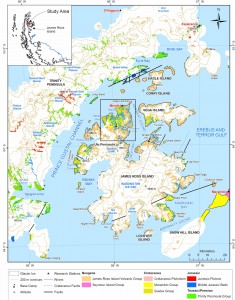
Trinity Peninsula, northern Antarctic Peninsula, is made up of hard igneous and metamorphic rocks, including granites, granodiorite, quartz monazite and gabbro13-15. James Ross Island, in comparison, comprises Late Cretaceous sedimentary strata, which occasionally bears fossils, overlain by the Neogene James Ross Island Volcanic Group13-19. You can read more about volcanoes on James Ross Island on the Cambridge Volcanology Group website and on our Subglacial Volcanoes page.
Glacial history
During glaciations throughout the Quaternary, James Ross Island was overwhelmed by ice sheets from Trinity Peninsula, which deposited numerous granitic erratics across the island14,20,21. Glacial drift, drumlins and moraines have been described from Ulu Peninsula22-26. Prince Gustav Ice Stream developed during the Last Glacial Maximum (LGM), diverting ice flow north and south around the island27,28. This ice shrank back from the continental shelf edge around 18,000 years ago, with recession to the inner continental shelf between 17,500 and 9100 years ago20,21,29. Mean ages from cosmogenic nuclide dating of boulders on Cape Lachman indicate that the ice sheet had disappeared from northern James Ross Island by around 8,000 years ago20.
Methods
Geomorphological mapping was achieved through the visual interpretation of satellite images and aerial photographs, and through an intensive field campaign that covered 200 km2 on Ulu Peninsula from January to March 2011. Glaciological structures, sediments and landforms were identified on remotely sensed images and in the field according to standard procedures, using previously defined criteria30-35.
Sediments were characterised quantitatively through the collection of numerous samples of 50 pebbles. Stone lithologies were identified, and pebbles were measured for shape-roundness data36,37.
Sediment-landform assemblages
As a result of these analyses, six sediment-landform assemblages were identified, and they are summarised in the table below. They represent landforms dating from the Neogene to the present day, under a range of different environmental conditions.
| Assemblage | Principle land elements | Age of formation | Interpretation |
| Glacier snow and ice | Glacier ice (cirque, tidewater, valley, dome); snow patches | Holocene to present day | Contemporary glaciation. Small cold-based cirque and plateau glaciers dominate. |
| Glacigenic | Erratic-poor drift; erratic-rich drift in coastal regions and cols and passes; moraine fragments | LGM | James Ross Island overwhelmed by Antarctic Peninsula Ice Sheet. Erratic-rich drift from the margins of Prince Gustav Ice Stream. |
| Boulder train | Boulder train, Brandy Bay moraine, IJR-45 Glacier moraine | Mid-Holocene | Readvance of IJR-45 to form a marine-terminating glacier in Brandy Bay |
| Ice-cored moraine | Ice-cored moraines in front of cirque glaciers | Late Holocene | Late-Holocene readvance of small glaciers |
| Paraglacial | Scree slopes, boulder lags on beaches, ventifacts, spits and beaches, marine terraces, rivers and streams, mass movements | Holocene to present | Paraglacial reworking of glacigenic sediments and landforms |
| Periglacial | Rock glaciers, nivation hollows, protalus ramparts, freeze-thaw shattering, solifluction, mesas, blockfields | Holocene to present | Periglaciation of James Ross Island, with a deep permafrost and a seasonal active layer. |
Glacier snow and ice assemblage

James Ross Island has numerous small cirque, valley, tidewater and plateau dome glaciers. Most of these are receding38,39, but the land-terminating glaciers have only small rates of recession. 100-200 m of recession has occurred since the most recent readvance, when prominent ice-cored moraines were formed39. Davies Dome and IJR-45 Glacier (also known as Whisky Glacier) are thinning40. Glacier surfaces are layered and supraglacial debris is common. Most of the small glaciers are free of crevasses.
Perennial snow banks lie in the lee of hill slopes, and feed small streams on positive degree days. These snow banks are sometimes associated with protalus ramparts and nivation hollows.
The small cirque glaciers have little evidence of modern thrusting, and are passively downwasting and receding, with a negative mass balance39. Some of the glaciers have become detached from their plateau accumulation areas, which has further encouraged ice stagnation.
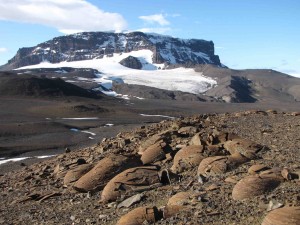
Glacigenic assemblage
Ulu Peninsula is covered with a superficial drift sheet dominated by basalt pebbles and occasional erratics, which together form an armoured surface that overlies sand. In some coastal areas, this drift sheet is overprinted by marine terraces. Three principal glacial drifts are identified, and they are summarised in the table below.
| Land element | Sediments | Landforms | Process and interpretation | Age |
| Erratic-poor drift | Basalt pebble-cobble gravel; in paces with local sandstone and siltstone | Smooth, flat surfaces. Widespread across Ulu Peninsula. | Deposition beneath a cold-based, slow-moving ice sheet | LGM |
| Erratic-rich coastal drift | Abundant erratics. Found along western coast of Ulu Peninsula. | Constructional ridges, moraine fragments, smooth slopes. | Deposition beneath a fast-flowing ice stream. Lateral moraines. | LGM |
| Erratic-rich patchy drift in cols and passes | Numerous erratic boulders on a basalt pebble-cobble gravel | Occasional moraine fragments; streamlined bedrock ridges | Deposition beneath wet-based ice sheet; sheet flow. | LGM |
Erratic-poor drift
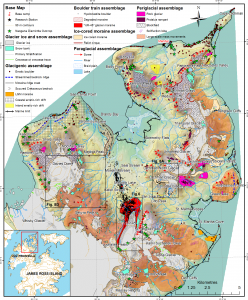
A erratic-poor drift is widespread across Ulu Peninsula, and comprises unlithified (loose, not rock-like) subangular basalt pebbles and cobbles forming a lag on the surface, which frequent basalt boulders and rare granite erratic boulders. It is typically more than 90% basalt. Boulders can be faceted and striated. Periglacial stone stripes or patterned ground are often well developed on this surface.
Drift sheets such as these are often found in deglaciated Antarctic regions, including the Dry Valleys41, where they are inferred to have been deposited by cold-based ice (see Glacial Thermal Regime). The climate of the Dry Valleys is probably comparable with the climate on James Ross Island during the Last Glacial Maximum. Silt, clay and fine materials are typically absent. This erratic-poor drift is interpreted as being deposited by slow-moving, cold-based ice during the Last Glacial Maximum.
Erratic-rich drift
In some coastal regions adjacent to Prince Gustav Channel, such as Lewis Hill, there are drift sheets comprising poorly compacted, unsorted sandy boulder gravel with high percentages of Trinity Peninsula erratics and increased silt content in the matrix. These erratic-rich sediments are associated with constructional ridges and moraine fragments, such as at Kaa Bluff. Erratic-rich drift also occurs patchily in cols and passes, such as Baloo Col and San José Pass.
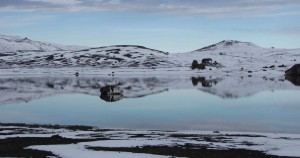
During the LGM, Prince Gustav Ice Stream flowed northwards along the north-western coast of James Ross Island28,42, and impinged upon its coastal regions, resulting in the formation of lateral moraines and the erratic-rich drift.
Patches of erratic-rich drift also occur in cols and passes. The large accumulations of erratics indicate enhanced deposition and wet-based subglacial conditions. As ice flowed over the passes, it became focussed and compressional stresses increased. Pressure melting point was reached, allowing subglacial deposition and resulting in the erratic-rich sandy boulder gravels and further erosion of the cols43. Both ice deformation and frictional sliding can increase basal ice temperatures44. These patches of erratic-rich drift are therefore interpreted to be a result of changes in the subglacial thermal regime of the ice sheet during LGM glaciation, which can create mosaics of selective erosion and deposition45,46.
Boulder train assemblage
The Boulder train assemblage comprises the boulder train and glacial drift, and the Brandy Bay Moraine. It also includes the IJR-45 Glacier Moraine. These features are associated with a mid-Holocene readvance of IJR-45, dated to ~5,000 years ago24.
Boulder train and glacial drift
A train of large (7-10 m across) boulders of hyaloclastite and diamictite stretches from the western side of IJR-45 Glacier Moraine to a low ridge flanking Brandy Bay. The sediments associated with this boulder train are a sandy boulder gravel, with rare granite boulders. The surficial sediments are similar to the LGM erratic-poor drift. They are stratigraphically younger than (i.e. lie on top of) the coastal erratic-rich drift. The large, intact hyaloclastite boulders are perched on, rather than lodged in, the surficial sediments. These friable boulders would not survive subglacial transport or reworking, and it is likely that they were transported supraglacially by a mid-Holocene readvance of IJR-45 Glacier. The boulder train was probably formed by marginal dumping. Rapid (possibly cold-based) recession may have protected these boulders.
Brandy Bay Moraine
The ridge bounding the SW coastline of Brandy Bay is ~30 m high with a rounded, undulating crest. It is ~3.5 km long and up to 0.7 km wide. It declines in elevation seaward (east to west). The surficial sediments are a basalt pebble-cobble lag with a fine silt matrix buried beneath the cobble armour. There are rare granite boulders, increasing in number seawards. Hyaloclastite boulders decrease in size and number seawards, and weathering and degradation of the boulders increases.
This ridge has previously been interpreted as a moraine24, and we name it ‘Brandy Bay Moraine’. Drumlins have been reported in association with this moraine22, but here they are interpreted as remnants of a formerly thicker drift sheet, that has since been dissected by ephemeral streams and periglacial slope processes.
The basalt drift and rare granite erratics were derived from reworking of LGM drift sheets, and the hyaloclastite boulders can be traced to source at Lookalike Peaks.
The photographs below illustrate the various facies of the Boulder Train Assemblage.
IJR-45 Glacier Moraine
IJR-45 Glacier Moraine is up to 1 km wide, with low slope angles until the edge of the moraine, where it drops off sharply. The glacier trunk has clean ice and ice with a thin debris cover. The lateral-frontal complex (closest to the current ice margin) comprises a chaotic assemblage of small, sharp-crested ridges 1-3 m high and up to 1 m wide, often with lines of boulders on their crests. Ice scars are often visible. This region of ice-cored moraine extends ~50 m from the glacier snout.
The next 50-160 m are characterised by increasingly degraded down-wasting back scars of ice, with exposed stratified white and blue ice and small, sharp-crested ridges 1-3 m high. There are numerous small perched ponds.
From 160-400 m from the glacier snout, there are subdued, crescent-shaped scars, circular niches and ridges with no ice visible. There are numerous large hyaloclastite boulders, weathering and downwasting in situ. From 400-1000 m from the glacier snout, the ridges widen and flatten downslope into a 100 m wide ridge, sometimes with small 5 m high ridges and isolated mounds. Stone stripes and patterned ground are well developed. From 1000 m to the edge of the moraine, the moraine is characterised by smooth, steep slopes with loose scree, frost-shattered boulders, well-developed stone stripes, drained lakes and subdued ridges.
IJR-45 Glacier Moraine is characterised by five different zones, ranging from fresh, actively back-wasting ice scars in the frontal-lateral complex, grading outwards to increasingly smoother slopes, more uniform and compacted sediments, and increasing weathering, disintegration of hyaloclastite boulders, and periglacial development. These features suggest that the outer parts of the moraine have an older age than the other smaller ice-cored moraines on Ulu Peninsula.
Ice-cored moraine assemblage
Ice-cored moraines in front of small cirque glaciers and abandoned cirques are the youngest landforms on Ulu Peninsula. They date from a readvance of small glaciers in the last 1000 years39. The cirques have steep backwalls, a rounded, over-deepened basin, and some are occupied by small glaciers or occasionally by lakes.
The ice-cored moraines have multiple sharp-crested ridges, numerous small lakes and ponds, and surficial sediments ranging from sandy boulder gravel through to openwork basalt boulders and diamicton. Exposures show stratified ice (layered blue, white, bubble-poor and bubble-rich ice), sometimes with debris in.
These hummocky moraines are primarily composed of stratified glacier ice. The stratified ice contains basal ice (with debris) and surface ice (white, bubble-rich). Ice with laminated debris is formed though the attenuation by ice creep47,48.
The debris on the moraines is mostly basalt, primarily derived from rockfall from the headwalls onto the glacier surface. The terminal moraines contain more rounded pebbles (occasionally striated), indicating greater distances of subglacial transport, whilst the high lateral moraines contain very angular pebbles, indicating a higher input of supraglacial material.
Paraglacial assemblage
Paraglacial processes, meaning processes which are involved in the readjustment of a landscape from glacial to non-glacial conditions, are strongly apparent on James Ross Island. Here, they include fluvial and marine transportation of sediments, relaxation of steep slopes, mass movements, and aeolian (wind-blown) processes. On Ulu Peninsula, paraglacial sediments and landforms overprint the glaciological story.
Marine terraces and raised beaches
Below 30 m above sea level on Ulu Peninsula, there are smooth, flat slopes, an absence of large boulders and more rounded pebbles. In some places there is a series of flat terraces with rounded pebbles. These are marine terraces, formed during and after deglaciation, following isostatic uplift of the land.
Spits and modern beaches
Northern James Ross Island is fringed with beaches, some with sandy spits. On some of the beaches there are large numbers of erratic boulders. These spits were formed by the reworking of glacial and fluvial sediments in the littoral zone (wave-washed zone on the beach). Littoral longshore currents transported formerly deposited glacial and fluvial material along the beach. Glacially transported boulders are left behind as a lag on the beach. Unstable steep slopes behind beaches are subjected to solifluction and over-steepening, and erosion of these cliffs may also contribute erratic boulders.
Rivers and streams
Ephemeral (temporary, seasonal) streams and braided streams on Ulu Peninsula typically have multiple channels, with an active river width of up to 100 m. There are incised stream cuts, small islands, point bars and longitudinal mid-channel bars49. The pebbles are typically rounded and clast-supported, and incision is typically around 1-2 m.
These small streams are fed by perennial snowfields and small glaciers, and their discharge varies considerably during the day/night (diurnal) cycle, and on weekly and monthly timescales. On warm days, with increased melt, they are capable of winnowing glacial sediments and incising Cretaceous bedrock.
The photographs below show a number of paraglacial phenomenon on Ulu Peninsula, James Ross Island.
Aeolian sediments and landforms
Glacial drifts on Ulu Peninsula are frequently covered by a basalt pebble-cobble armour, commonly only 1-2 pebbles thick, with sand beneath. Accumulations of sand are also found on snowfields. Many of the boulders have smooth, plano-concave sides, and red staining is common on many granite boulders.
The lag of pebbles is due to winnowing by strong winds. These winds remove fines from the surface, leaving behind only those protected underneath the pebble-cobble armour. The dry, unvegetated climate makes the island susceptible to aeolian deflation like this, and strong katabatic winds exacerbate the process.
The boulders with smooth plano-concave and convex sides are ventifacts, moulded by the wind and sand-blasted into new shapes. They are typical of recently deglaciated, periglacial environments, where there is a large availability of unburied boulders, strong winds and readily available sand50. In some places, the wind has created beautiful shapes and curved on the boulders.
The red staining on the boulders is a red desert varnish, enriched in iron. Iron oxides are leached out of the rock and deposited on the surface as a varnish51. Well-developed desert varnish occurs in semi-arid, sheltered areas, away from wind abrasion.
Scree slopes
Scree slopes are common beneath the steep basalt cliffs, and are an important input into moraines, rock glaciers and protalus ramparts. The pebbles from scree slopes are more angular than those from the glacigenic drifts and are similar to the high lateral moraines on small cirque glaciers.
The steep basalt cliffs contain vertically jointed hyaloclastite deltaic deposits, which are particularly susceptible to rock weathering and scree slope formation. After recession of the glacier ice, fracturing occurs due to stress release. The exposure of the cliffs to the air makes them vulnerable to freeze-thaw activity in the periglacial climate. This has resulted in rapid readjustment and the formation of new scree slopes.
Large scale mass movements
Large-scale mass movements are evident on Ulu Peninsula were the James Ross Island Volcanic Group rests on gently inclined, poorly consolidated Cretaceous mudstone. These large-scale mass movements involve volcanic blocks many tens of metres high (the full thickness of the local volcanic sequence), and a few hundred metres long, forming enormous jumbled heaps.
These large scale mass movements are controlled by gravity acting on steep-fronted brittle rock masses (delta margins), resting on soft, ductile, Cretaceous sediments. They are geologically controlled, with the upper surface of the Cretaceous muds representing a slip-surface (décollment surface) on which the volcanic blocks can slide. Instability probably occurred after the removal of surrounding ice, and many of the mass movements may span several interglacial periods.
Periglacial assemblage
Periglacial and paraglacial processes are intertwined on James Ross Island, and massive ground ice and glacier ice underlie many of the landforms. The active layer here is approximately 1 m thick52-54.
Rock glaciers
Rock glaciers are lobate or tongue-shaped landforms comprising a mixture of rock and ice, typically with a furrowed form, ridges, ponds, and a steep terminus and sides. They can be derived from scree slopes (talus-derived) or glacier-derived. Glacier-derived rock glaciers form part of a continuum with, and can evolve from, ice-cored moraines55,56.
There are six rock glaciers near Lachman Crags alone. Some are located near the end of ice-cored moraines, and merge with these moraines12,26,57. The rock glaciers are distinguished from ice-cored moraines by evidence for down-slope movement, including arcuate ridges and furrows. Rates of flow have been measured at ~0.2 m per year58.
Protalus ramparts
Protalus ramparts on James Ross Island are curved, flat features on steep slopes, found in association with scree and perennial snow banks. They have a sharp break in slope on their down-slope side, where the talus rests at the angle of repose. Numerous protalus ramparts are found on Ulu Peninsula, along Johnson Mesa, the western slopes of Lachman Crags and below Davies Dome mesa. They form by pebbles rolling down the snow banks. A mesa is a high, flat mountain; in this case, flood basalt deltas form flat-topped mountains.
Slope processes
Solifluction lobes are apparent on many moderate and low-gradient debris-mantled slopes on the island. Many boulders on these slopes are ‘ploughing’ into the sediment, with a keel at the down-slope edge.
Alluvial fans and valley-fills are also important on James Ross Island, with streams, snow avalanches, debris flows and solifluction resulting in gentle fan-shaped sediment accumulations in many valleys. Some of this valley fill has been dissected by rivers and streams, with sorted material being deposited downstream. Rock streams (sensu59) were seen in small valleys, with coarse rock debris forming a linear deposit with a down-slope alignment. They typically have a single thread down the valley axis.
The photographs below show a series of periglacial features on Ulu Peninsula, James Ross Island.
Frost creep is one of the main components of solifluction, with melting ice lenses within the sediment providing water, which reduces the internal friction and cohesion within the regolith. The sediments are slowly deformed through freeze-thaw activity under the influence of gravity, and slide downslope in a series of lobes.
Unvegetated slopes with thick glacial drifts are susceptible to erosion by slope failure, debris flows, tributary streams and surface wash, resulting in gullying, slope-foot debris cones and valley floor deposits3.
Freeze-thaw sediments and landforms
Evidence for modification of surface sediments by freeze-thaw includes frost-shattered boulders, nivation hollows and nivation processes, sorted stone polygons and stripes (sometimes vegetated by lichens and mosses), and surface cracks. Nivation hollows are common, and are related to small, late-lying snow patches. Shattered boulders occur through mechanical weathering induced through freezing and thawing in a periglacial environment60.
Sorted polygons (cf. 61) comprise hexagonal cells of sand and fine to coarse gravel, surrounded by angular coarse gravel and boulders. Pattern widths are 0.4-4 m. They are particularly prevalent in areas with abundant water, such as near streams and snow banks. Stone stripes with alternating coarse and fine sediment are well developed on some slopes. Weathering and down-slope transportation of basalt cobbles on Cretaceous sandstone bedrock has resulted in some striking black stone stripes. Patterned ground overprints most landforms on James Ross Island.
Polygons on the ground surface may form through the development of vertical ice wedges in the ground. Sorted polygons and stone stripes both form through diurnal needle-ice growth. Freezing and thawing of needle ice results in creep on sloping surfaces61. Networks of cracks are interpreted as being the product of the fissuring of seasonally frozen ground.
The availability of water may be a limiting factor in the freeze-thaw cycles that form these features, which are generally more common near streams, nivation hollows and snow patches. More liquid water is present downslope of snow banks, resulting in ice wedge growth and more well-developed polygons and stripes.
Mesas and blockfields
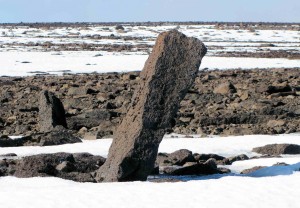
The surface of Lachman Crags mesa (400 m high) is smooth and flat, with stone stripes and stone polygons across its surface. The surficial sediments are mostly basalt clasts, with rare, well-embedded, rounded granite boulders. Above 380 m, the sediments form a blockfield of large, angular basalt boulders, which are not faceted nor striated, and many are subvertical as a result of frost upheaval.
Blockfields develop under periglacial conditions on level or gently undulating relief. They form as a result of in situ weathering of bedrock, with limited downslope movement of blocks62,63. The blockfields on James Ross Island have developed on the Neogene basalt plateaux, where there is abundant periglacial frost action. The presence of granites suggests that at some point, the high mesas may have been overridden by ice from the Antarctic Peninsula.
Processes of landscape evolution in a semi-arid polar environment
Using the glaciological, geological and geomorphological studies undertaken on James Ross Island, we present a new landsystems model for landscape evolution, which will aid the interpretation of past, present and future glacierised and glaciated environments (note: glacierised means currently with glaciers; glaciated means it once had glaciers but doesn’t any more).
A key feature of this new model is the multi-temporal approach. Six sediment-landform assemblages were described and interpreted in the above sections, and they mark a change from landscape dominance by large-scale glaciation during the LGM and Mid- and Late-Holocene glacier readvances, and paraglacial and periglacial processes throughout the Holocene and into the present day.

The polar desert landsystem on Ulu Peninsula is strongly controlled by the geology; basalt flood-delta mesas dominate the landscape, while being underlain by softer Cretaceous marine deposits; a basalt pebble-cobble gravel covers most land surfaces. The large scale mass movements are predicated by the presence of basalt deltas, likely to be uncommon in other polar environments, although similar features have been noted elsewhere (e.g., Skye).
The landscape was overprinted by ice from the Antarctic Peninsula during the LGM. This ice sheet, and previous incarnations, has sculpted and moulded Ulu Peninsula. Variations in its thermal regime and ice-stream activity have resulted in differences in the glacial drift. Following deglaciation, paraglacial and periglacial processes immediately began to modify the landscape.
Glacial-paraglacial-periglacial interactions
A latitudinal transect from northern Chile through to the Dry Valleys of Antarctica highlights the changing dominance of different processes, driven primarily by the availability of water. Meltwater is increasingly available important at more northerly latitudes (i.e., closer to the equator). The fast-flowing, temperate glaciers of the Northern Patagonian Icefield produce large volumes of meltwater, which rapidly rework and remove fines generated subglacially. Subglacial landforms are rare, because after glacier recession they are removed by proglacial meltwater32, but there are large glaciofluvial ice-contact landforms. The meltwater also facilitates basal sliding and enables glaciers to flow quickly, resulting in abundant ice-scoured bedrock.

In contrast, the sediment-landform assemblage near Tierra del Fuego, southern Chile (53°S), is dominated by abundant subglacial till, flutes, drumlins and moraines, deposited by temperate glaciers with reduced proglacial meltwater, which aids the preservation of these landforms. There is discontinuous permafrost only, resulting in fewer rock glaciers, protalus ramparts, frost-shattered boulders or stone polygons than on James Ross Island. Aeolian processes are also comparatively less important; ventifacts and pebble-cobble lags are more important in Antarctica because of the faster, sand-bearing winds, less vegetation and less fine-grained, muddy, sticky surficial sediment than in temperate regions.
On James Ross Island, freeze-thaw and fluvial activity have far greater importance than the colder, drier Dry Valleys (cf. 64-66), which significantly aids the development of patterned ground and solifluction landforms. The prevalence of moisture-driven periglacial processes on Ulu Peninsula contrasts sharply with their absence in more southerly, colder parts of Antarctica. In contrast, the glacigenic assemblage on James Ross Island more closely resembles the cold-based glacial sediment-landforms assemblages recognised in East Antarctica43,67-69, perhaps indicating similarities between climate during the LGM on James Ross Island and the climate in East Antarctica today.
Some paraglacial processes, such as glacio-isostatic adjustment and marine terrace formation, and relaxation of rock walls, occur throughout the transect, although marine terraces are more prevalent in regions close to the sea and at sea level.
The scope for landscape modification at the intersection of a paraglacial-periglacial-glacial landsystem is of great importance. Ground ice is prevalent on James Ross Island today, in the form of permafrost, rock glaciers, buried glacier ice and ice-cored moraines. However, despite the wealth of research on glacial and periglacial processes, there are relatively few papers that discuss the actions of one set of processes upon the other.
The presence of permafrost beneath cold-based ice on James Ross Island during the LGM may have facilitated forward movement, as high porewater pressures beneath subglacial permafrost can reduce the shear strength of unfrozen substrate. This may also help initiate large scale mass movements. Proglacial permafrost can also reduce effective stress by over-pressurising groundwater70. Entrainment of debris occurs through the transmission of basal shear stress from the glacier bed into the frozen subglacial sediment71.
Character and behaviour of the LGM ice sheet on Ulu Peninsula
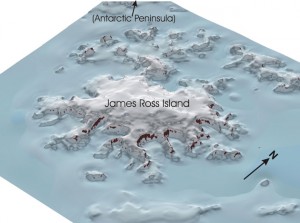
The basal thermal regime of ice sheets represents important empirical data required for numerical ice-sheet models. The subglacial thermal regime on Ulu Peninsula comprised four principal types: a wet-based ice stream, warm-based sheet flow, cold-based sheet flow and cold-based plateau ice caps. Each leaves a distinctive sediment-landform assemblage behind in the geological record. There is evidence of frozen-bed patches with slow sheet flow. Marine geological evidence has been taken to suggest that there was cold-based ice on Antarctic Peninsula mountains during the LGM72,73. The mesas may have harboured ice domes during the LGM period, if they were above the height of the LGM ice sheet. Ice streaming and rapid basal sliding may have been encouraged by slippery marine sediments in Prince Gustav Channel.
The table below summaries some of the key features and inferred thermal regimes of different glacial drifts found on Ulu Peninsula.
| Glacial drift | Characteristics | Inferred thermal regime |
| Erratic-poor glacial drift | Sandy boulder gravel, found widely across Ulu Peninsula | Cold-based sheet flow |
| Erratic-poor glacial drift | On mesas and around Davies Dome. Smooth and flat, no landforms | Cold-based plateau ice cap |
| Erratic-rich drift (in cols and passes) | Sandy boulder gravel in cols and passes with Trinity Peninsula erratics. | Warm-based sheet flow |
| Erratic-rich drift (in coastal regions) | Sandy boulder gravel, up to 50% erratics, associated with moraine fragments | Ice stream (warm-based streaming flow) |
The glacial sandy boulder gravel that characterises James Ross Island today is significantly different to the Neogene diamictite logged in many places across the island19,74,75. Similar contrasts have been noted in the Dry Valleys, where pebble gravels deposited by cold-based glaciers differ from the Neogene Sirius Group diamictons68. This is indicative of changing climatic regimes, with diamicton, silt and clay forming only under the warmer conditions of the Neogene (cf. 76,77). Warmer atmospheric temperatures encouraged basal sliding, erosion, transportation and deposition under a wet-based ice sheet, with abundant production of fines through glacial abrasion, producing diamictites (note: a diamictite is a lithified diamicton). Abrasion under cold-based glaciers is insufficient to produce the large quantities of fines needed for subglacial till formation, which is associated with warm-based glaciers above the pressure melting point. As well as warmer atmospheric temperatures, geothermal heating may also have helped Neogene glaciers reach pressure melting point.
This study has shown that cold-based ice sheets are capably of entraining and moving subglacial sediments, and supports a new and emerging paradigm of sheet flow in high latitude regions. The old paradigm suggested that ice sheets comprised a patchwork of cold-based ice on mountain tops, with little or no erosion or deposition, surrounded by highly active warm-based ice that typically occupied valleys78,79. New and emerging research suggests that this is an oversimplification, and that sheet flow is more complex. Although cold-based glaciers are weak erosional and depositional agents compared with warm-based glaciers, their thermal regime and their beds is more subtle than previously thought43,80.
The ice sheet that overwhelmed James Ross Island during the LGM was a composite of ice streaming in the trough of Prince Gustav Channel, which impinged on the coastal margins of Ulu Peninsula. Sheet flow occurred on the main part of the peninsula, with both warm- and cold-based ice flowing across the island, and cold-based and stationary ice domes on high plateaux blockfields. The lateral margins of Prince Gustav Ice Stream were likely to have been dominated by warm-based sheet flow; the evidence for this includes moraine fragments and enhanced deposition of erratics.
Conclusions
This holistic and systematic study of Ulu Peninsula on James Ross Island has used detailed sedimentary descriptions, clast lithology, shape-roundness data and geomorphology mapped from both remotely sensed images and in the field to discriminate six sediment-landform assemblages and thus to present the first landsystem model from a semi-arid polar environment from the Antarctic Peninsula.
The conceptual model emphasises the interrelationship and importance of glacial, periglacial and paraglacial processes. We identified, (1) a glacier snow and ice assemblage; (2) a glacigenic assemblage; (3) a boulder train assemblage; (4) an ice-cored moraine assemblage; (5) the paraglacial assemblage; and (6) a periglacial assemblage. Analysis of these assemblages provides a detailed understanding of landscape evolution on James Ross Island. Analysis of these assemblages provides a detailed understanding of landscape evolution on James Ross Island.
Sediments and landforms were deposited during LGM glaciation and during mid- and Late-Holocene glacier readvances. They were subsequently reworked and deposited by periglacial and paraglacial processes, throughout the Holocene and into the present day. Crucially, when compared with other landsystem models, we find that the availability of meltwater encourages strong landform modification by periglacial processes. These processes would have been similarly important during Late Pleistocene glaciation in the Northern Hemisphere. Therefore, the landsystem model presented here is a modern analogue to be used in the interpretation of past glaciated environments.
This paper presented new information regarding the thermal regime of the Antarctic Peninsula Ice Sheet during LGM glaciation. The data and the model for the interplay between cold-based, warm-based and streaming ice challenges the theory that cold-based glaciers do not erode or deposit. Finally, this paper presented important new data regarding the thermal regime and character and behaviour of the Antarctic Peninsula Ice Sheet during the LGM, which will aid reconstructions of the LGM ice sheet in the northern Antarctic Peninsula.
Further reading
- Little Ice Age ice-cored moraines
- Glacier change on the Antarctic Peninsula
- Antarctic Peninsula Ice Sheet Evolution
- James Ross Island photographs
- Subglacial Volcanoes
- Antarctic Periglacial Environments
Citation
Please cite the paper as:
The full paper can be downloaded from the link above. Please email the authors if you cannot access this publication.

